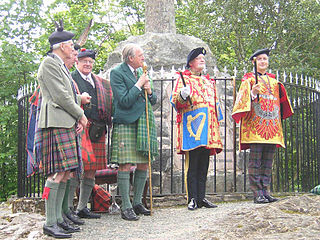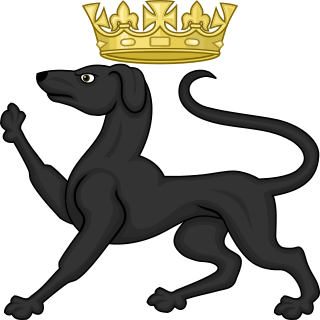
A private officer of arms is one of the heralds and pursuivants appointed by great noble houses to handle all heraldic and genealogical questions.

A private officer of arms is one of the heralds and pursuivants appointed by great noble houses to handle all heraldic and genealogical questions.
Since the development of heraldry in the Middle Ages and the rise of officers of arms, noble families have appointed heralds and pursuivants to look after the correct marshalling of their coats of arms and research genealogical links. Many noblemen in Britain retained heralds from about 1170 onwards, as did important knights such as Sir John Chandos. The heralds were originally concerned with war and tournaments and identifying people by their arms. As such, they naturally developed an interest in genealogy. Formerly, the Lord of the Isles had Ross Herald and Islay Pursuivant. On the forfeiture of the Lordship these became, and remain, Royal Officers. In 1725, Blanc Coursier Herald was created to serve Prince William, Duke of Cumberland, and the tabard of the office includes Prince Williams differenced arms. Today, most officers of arms are employed by state heraldic authorities. There are, however, some private officers that still exist.

In Scotland, there are four private pursuivants of arms that are recognized by the Court of the Lord Lyon King of Arms. These are appointed by clan chiefs to look after matters of clan heraldry and genealogy. The five currently recognized private Scottish pursuivants are listed below:
In 10 November 1962 Fernando Muñoz Altea was appointed King of Arms of the Royal House of the Two Sicilies by the claimant Prince Ranieri, Duke of Castro, and Head of the Royal House. [1] The Kingdom of Sicily did not have actual heralds (to grant coats of arms and issue certificates of nobility) in recent times, but rather a Commission for Titles of Nobility based in Naples until 1861. [2] This commission concerned itself with administration of certain nobiliary institutions and recognition of titles of nobility. [3] Muñoz Altea continued this tradition as a Private Officer of Arms of the Royal House. In addition to his office as King of Arms, Muñoz Altea was a delegate of the Sacred Military Constantinian Order of Saint George. [4] He died in Mexico City on March 2, 2018.

A coat of arms is a heraldic visual design on an escutcheon, surcoat, or tabard. The coat of arms on an escutcheon forms the central element of the full heraldic achievement, which in its whole consists of a shield, supporters, a crest, and a motto. A coat of arms is traditionally unique to the armiger. The term itself of 'coat of arms' describing in modern times just the heraldic design, originates from the description of the entire medieval chainmail 'surcoat' garment used in combat or preparation for the latter.

The Right Honourable the Lord Lyon King of Arms, the head of Lyon Court, is the most junior of the Great Officers of State in Scotland and is the Scottish official with responsibility for regulating heraldry in that country, issuing new grants of arms, and serving as the judge of the Court of the Lord Lyon, the oldest heraldic court in the world that is still in daily operation.

The College of Arms, or Heralds' College, is a royal corporation consisting of professional officers of arms, with jurisdiction over England, Wales, Northern Ireland and some Commonwealth realms. The heralds are appointed by the British Sovereign and are delegated authority to act on behalf of the Crown in all matters of heraldry, the granting of new coats of arms, genealogical research and the recording of pedigrees. The College is also the official body responsible for matters relating to the flying of flags on land, and it maintains the official registers of flags and other national symbols. Though a part of the Royal Household of the United Kingdom, the College is self-financed, unsupported by any public funds.

An officer of arms is a person appointed by a sovereign or state with authority to perform one or more of the following functions:

A pursuivant or, more correctly, pursuivant of arms, is a junior officer of arms. Most pursuivants are attached to official heraldic authorities, such as the College of Arms in London or the Court of the Lord Lyon in Edinburgh. In the mediaeval era, many great nobles employed their own officers of arms. Today, there still exist some private pursuivants that are not employed by a government authority. In Scotland, for example, several pursuivants of arms have been appointed by Clan Chiefs. These pursuivants of arms look after matters of heraldic and genealogical importance for clan members.

King of Arms is the senior rank of an officer of arms. In many heraldic traditions, only a king of arms has the authority to grant armorial bearings and sometimes certify genealogies and noble titles. In other traditions, the power has been delegated to other officers of similar rank.

Sir Malcolm Rognvald Innes of Edingight was Lord Lyon King of Arms of Scotland from 1981 until 2001.

The law of heraldic arms governs the "bearing of arms", that is, the possession, use or display of arms, also called coats of arms, coat armour or armorial bearings. Although it is believed that the original function of coats of arms was to enable knights to identify each other on the battlefield, they soon acquired wider, more decorative uses. They are still widely used today by countries, public and private institutions and by individuals. The earliest writer on the law of arms was Bartolus de Saxoferrato. The officials who administer these matters are called pursuivants, heralds, or kings of arms. The law of arms is part of the law in countries which regulate heraldry, although not part of common law in England and in countries whose laws derive from English law.

Sir Thomas Innes of Learney (1893–1971) was a Scottish officer of arms who was Lord Lyon from 1945 to 1969.

A herald, or a herald of arms, is an officer of arms, ranking between pursuivant and king of arms. The title is commonly applied more broadly to all officers of arms.

Finlaggan Pursuivant of Arms is the private officer of arms of the Clan Donald in Scotland.

Heraldry in Scotland, while broadly similar to that practised in England and elsewhere in western Europe, has its own distinctive features. Its heraldic executive is separate from that of the rest of the United Kingdom.
Elizabeth Ann Roads, is a former Scottish herald, an office from which she retired in 2021; in July 2018 she retired as Lyon Clerk at the Court of the Lord Lyon

The Cambridge University Heraldic and Genealogical Society was formed as the result of the merger in 1957 of a previous Heraldic Society with the Cambridge University Society of Genealogists.

The Honourable Adam Robert Bruce is a Scottish solicitor, businessman, and aristocrat who serves as an officer of Arms at the Court of the Lord Lyon.

Dingwall Pursuivant of Arms is a current Scottish pursuivant of arms of the Court of the Lord Lyon.

Linlithgow Pursuivant of Arms is a Scottish pursuivant of arms of the Court of the Lord Lyon.
A heraldic authority is defined as an office or institution which has been established by a reigning monarch or a government to deal with heraldry in the country concerned. It does not include private societies or enterprises which design and/or register coats of arms. Over the centuries, many countries have established heraldic authorities, and several still flourish today.

The Court of the Lord Lyon is a standing court of law, based in New Register House in Edinburgh, which regulates heraldry in Scotland. The Lyon Court maintains the register of grants of arms, known as the Public Register of All Arms and Bearings in Scotland, as well as records of genealogies.

Fernando Muñoz Altea was the King of Arms of the Royal House of Bourbon-Two Sicilies. He was a Spanish/Mexican historian, specialised in the study of the aristocratic European colonial families of the Americas. Muñoz Altea was born in Madrid (Spain) on November 22, 1925. He died in Mexico City on March 2, 2018. Don Fernando Muñoz Altea was considered the "Dean of the Kings of Arms", since due to his seniority in the trade, he was one of the very few and genuine Kings of Arms left in the world in his time. The extraordinary quality of his genealogical certifications and of his heraldic designs, which he carried out personally, is internationally renowned.